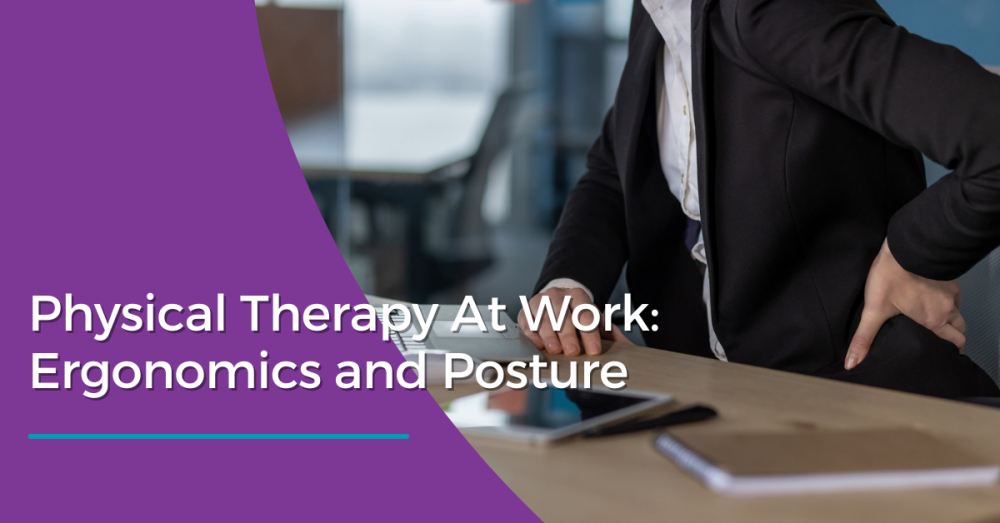Physical Therapy at Work: Ergonomics and Posture
Physical Therapy At Work: Ergonomics and Posture
Physical therapists don't just work in the clinic. Some play a key role in ergonomics - the science of designing or arranging workspaces, tools, and tasks to fit the person using them. The goal is to reduce strain, discomfort, and injury while improving comfort and efficiency.
For jobs like manufacturing, healthcare, or retail, PTs assess tasks like lifting, standing for long periods, or repetitive motions, then recommend adjustments to reduce strain and injury risk. This may include proper body mechanics training, workstation modifications, or tools to minimize physical stress. PTs also design strengthening and flexibility programs tailored to the demands of the job, helping workers stay pain-free and productive.
One of the most common tasks at work that causes pain? Working at a desk all day - whether at home or in the office. Poor posture, repetitive movements, and an improperly set-up workstation can lead to aches, pains, and even long-term injuries.
The good news? Physical therapists (PTs) can help you prevent discomfort and create a workspace that supports your body.
The Problem: Poor Posture and Workplace Strain
Sitting for long hours, slouching, or reaching awkwardly for your keyboard or mouse can cause:
- Neck and shoulder stiffness
- Lower back pain
- Wrist or forearm strain (like carpal tunnel syndrome)
- Headaches from tension
Some Tips to Try Today
If you work at a desk all day, here are some tips you can try to prevent or reduce aches and pains:
Move Regularly
Prolonged sitting can result in poor circulation to joints and muscles, create an imbalance in strength and flexibility, and lead to muscle strain. Frequent, short breaks can go a long way towards preventing these issues.
- Get out of your chair and move around - even for 30 seconds
- Move in your chair:
- Roll your shoulders backwards
- Turn your head side to side, or nod it up and down
- Stretch out your forearms and your legs
Set Up Your Workspace to Minimize Strain
Setting up your office for your body and the work you do will help you maintain a good posture and keep you more comfortable. Here are some guidelines:
- Your chair should be set up so your hips and knees are at 90 degrees
- Your arm rests should allow you to sit close to your desk
- Your keyboard should be positioned so your hands are slightly below your elbows
- Your monitor should be directly in front of you and at eye level
When to See a Physical Therapist
If you’re dealing with persistent pain or want to prevent future issues, our PTs can help. They’ll assess your posture, workstation, and movement patterns to create a plan tailored to your needs.
Ready to Feel Better at Work?
Contact us today for an evaluation and start working - and living - without pain!
References:
Research:
- Prall J, Ross M. The management of work-related musculoskeletal injuries in an occupational health setting: the role of the physical therapist. J Exerc Rehabil. 2019 Apr 26;15(2):193-199. doi: 10.12965/jer.1836636.318. PMID: 31111000; PMCID: PMC6509454.
- Philip Fabrizio, Ergonomic Intervention in the Treatment of a Patient With Upper Extremity and Neck Pain, Physical Therapy, Volume 89, Issue 4, 1 April 2009, Pages 351–360, https://doi.org/10.2522/ptj.20080209
- Ardalan Shariat, Joshua A. Cleland, Mahmoud Danaee, Mehdi Kargarfard, Bahram Sangelaji, Shamsul Bahri Mohd Tamrin, Effects of stretching exercise training and ergonomic modifications on musculoskeletal discomforts of office workers: a randomized controlled trial, Brazilian Journal of Physical Therapy, Volume 22, Issue 2, 2018,Pages 144-153, ISSN 1413-3555, https://doi.org/10.1016/j.bjpt.2017.09.003.
Articles and Content:
- https://www.apta.org/apta-magazine/2015/06/01/how-pts-are-transforming-the-workplace-with-ergonomics
- https://www.choosept.com/health-tips/workplace-wellness-office-ergonomics
- https://www.choosept.com/video/home-office-ergonomics
- https://www.choosept.com/video/exercise-posture-break-office-workers

